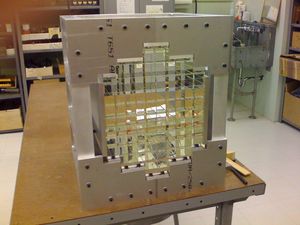Difference between revisions of "FCAL"
From GlueXWiki
(→FCAL calibration) |
|||
| (18 intermediate revisions by 4 users not shown) | |||
| Line 3: | Line 3: | ||
----- | ----- | ||
| − | The GlueX FCAL | + | The GlueX FCAL consists of 2800, 4 cm x 4 cm x 45 cm lead glass blocks stacked in a circular array. Each block is optically coupled to an FEU 84-3 PMT which will be instrumented with flash ADC electronics. |
GlueX-doc 985,988 and 989 document the GlueX Fcal as presented in the February 2008 Calorimetry Review. | GlueX-doc 985,988 and 989 document the GlueX Fcal as presented in the February 2008 Calorimetry Review. | ||
| − | === | + | === FCAL calibration === |
| − | *[[ | + | * [[FCAL calibration Meeting with the AIEC team]] |
| + | * Run periods | ||
| + | ** [[PrimEx-eta phase1 FCAL energy calibration]] | ||
| + | ** [[PrimEx-eta phase2 FCAL energy calibration]] | ||
| + | ** [[SRC FCAL time/energy calibrations]] | ||
| + | ** [[CPP FCAL time/energy calibrations]] | ||
| + | ** [[PrimEx-eta phase3 FCAL time/energy calibrations]] | ||
| + | |||
| + | === Shift Taker Reference Guide === | ||
| + | * [https://halldweb.jlab.org/hdops/wiki/index.php/Forward_Calorimeter_Shift FCAL Reference] | ||
| + | * [https://halldweb.jlab.org/hdops/wiki/index.php/Forward_Calorimeter_Expert Expert Page] | ||
| + | |||
| + | === Info For Data Analyzers === | ||
| + | [https://halldweb.jlab.org/wiki-private/index.php/FCAL_Analysis_Summary FCAL Summary] | ||
| + | === FCAL Expert Manuals === | ||
| + | * [https://halldweb.jlab.org/doc-private/DocDB/ShowDocument?docid=2770 Manuel's Manual] | ||
| + | * [https://halldweb.jlab.org/doc-private/DocDB/ShowDocument?docid=3336 Jon's FCAL base manual] | ||
=== Mechanical Design === | === Mechanical Design === | ||
| Line 17: | Line 33: | ||
* [[FCALLeadGlass]] | * [[FCALLeadGlass]] | ||
* Light Guides | * Light Guides | ||
| − | ** [ | + | ** [https://halldweb.jlab.org/doc-private/DocDB/ShowDocument?docid=850 Light-guide simulation] |
** [[Light guide tests]] | ** [[Light guide tests]] | ||
* [[Cosmic ray tests]] | * [[Cosmic ray tests]] | ||
| Line 38: | Line 54: | ||
=== Readout Electronics === | === Readout Electronics === | ||
| − | + | [https://halldweb1.jlab.org/wiki/index.php/FCAL_Readout_Electronics Write up by Scott Teige] | |
| − | * [ | + | === CW Bases === |
| + | *[[Investigations and Repairs]] | ||
| − | + | === Reconstruction === | |
| − | + | * Clustering algorithm from RADPHI: [http://zeus.phys.uconn.edu/radphi/nim-2-2004/NIM-6-2006/pubcopy.pdf NIM A 570 (2007) 384 ] | |
| − | + | * Photon reconstruction: [https://halldweb.jlab.org/doc-private/DocDB/ShowDocument?docid=823 GlueX-doc-823] | |
| − | + | ||
| − | + | ||
| − | + | ||
| − | + | ||
| − | + | ||
| − | + | ||
| − | + | ||
| − | + | ||
| − | + | ||
| − | + | ||
| − | + | ||
| − | + | ||
| − | + | ||
| − | + | ||
| − | + | ||
| − | + | ||
| − | + | ||
| − | * | + | * Nonlinear energy and depth corrections [https://halldweb.jlab.org/doc-private/DocDB/ShowDocument?docid=1093 GlueX-doc-1093] |
| − | + | === Previous Experiment References === | |
| − | * | + | * GlueX uses the same lead-glass bars and PMTs as the E852 and RADPHI experiments. Some relevant NIM articles for these experiments are given here. |
| + | * [https://halldweb.jlab.org/doc-private/DocDB/ShowDocument?docid=3251 E852 Calorimeter NIM] | ||
| + | * [https://halldweb.jlab.org/doc-private/DocDB/ShowDocument?docid=3252 RADPHI General NIM] | ||
| + | * [https://halldweb.jlab.org/doc-private/DocDB/ShowDocument?docid=3253 RADPHI Calorimeter Resolution and Gain Balancing] | ||
Revision as of 09:48, 31 October 2022
The GlueX FCAL consists of 2800, 4 cm x 4 cm x 45 cm lead glass blocks stacked in a circular array. Each block is optically coupled to an FEU 84-3 PMT which will be instrumented with flash ADC electronics. GlueX-doc 985,988 and 989 document the GlueX Fcal as presented in the February 2008 Calorimetry Review.
Contents
- 1 FCAL calibration
- 2 Shift Taker Reference Guide
- 3 Info For Data Analyzers
- 4 FCAL Expert Manuals
- 5 Mechanical Design
- 6 Radiation Damage
- 7 Optical Measurements
- 8 Electromagnetic Background
- 9 Options for Radiation-Hard Insert
- 10 Readout Electronics
- 11 CW Bases
- 12 Reconstruction
- 13 Previous Experiment References
FCAL calibration
- FCAL calibration Meeting with the AIEC team
- Run periods
Shift Taker Reference Guide
Info For Data Analyzers
FCAL Expert Manuals
Mechanical Design
- FCALPhotos
- FCALPMT
- FCALLeadGlass
- Light Guides
- Cosmic ray tests
Radiation Damage
Optical Measurements
Electromagnetic Background
Options for Radiation-Hard Insert
Readout Electronics
CW Bases
Reconstruction
- Clustering algorithm from RADPHI: NIM A 570 (2007) 384
- Photon reconstruction: GlueX-doc-823
- Nonlinear energy and depth corrections GlueX-doc-1093
Previous Experiment References
- GlueX uses the same lead-glass bars and PMTs as the E852 and RADPHI experiments. Some relevant NIM articles for these experiments are given here.
- E852 Calorimeter NIM
- RADPHI General NIM
- RADPHI Calorimeter Resolution and Gain Balancing
